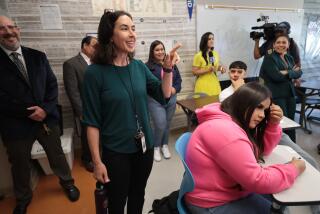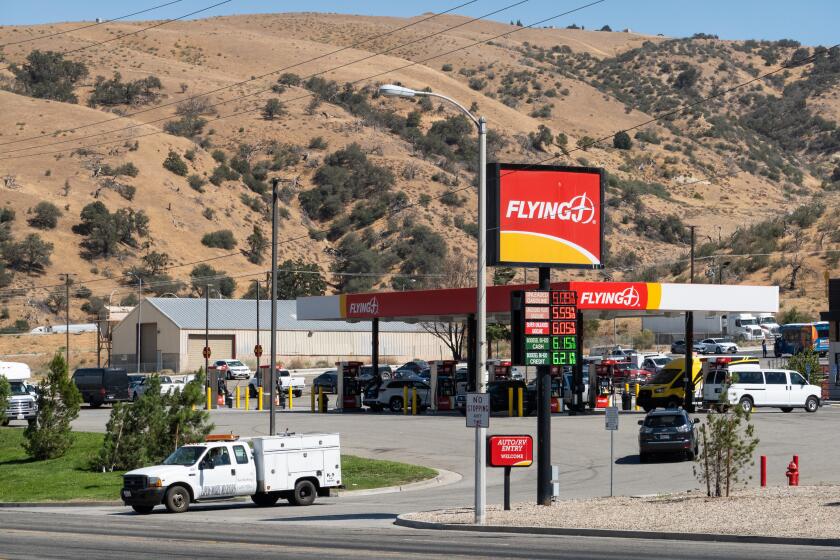L.A. Unified finally hiring teachers again
- Share via
After an extended period of layoffs and hiring freezes, the Los Angeles Unified School District has resumed bringing on new teachers, while also being more selective about their quality than in the past.
The nation’s second-largest school system forecasts hiring 1,333 instructors for next year; it hired 718 for the current year. The total teaching force numbers about 26,000.
The turnaround represents the first significant positive change in the employment climate since 2007; each year since, the district had faced significant budget cuts — from an economic recession, a drop in federal funding and declining enrollment.
Help has come from an improving economy, a voter-approved tax increase, and, perhaps most importantly, a demand for teachers that is finally outstripping the supply.
“We are now entering that point,” said L.A. schools Supt. John Deasy, where the district is finally able to “undo” some of the harm from “years of cuts.”
“It’s an exciting time,” said Mary Ann Sullivan, principal at 24th Street Elementary in South Los Angeles.
One of Sullivan’s new hires is Samantha Pulliam, 27, whose first-grade classroom gave no indication recently that she is a rookie L.A. Unified instructor. Walls, whiteboards and windows were filled with colorful displays: an exhibit of student writings and drawings about the story “Kitten’s First Full Moon”; an explanation of the color wheel; calendars to mark lost baby teeth and birthdays; a poster with the parts of an essay; a chart that defines books and stories by genre.
Pulliam used the word “genre” with her first-graders, who gathered around her attentively discussing whether a story about pigs was fiction or nonfiction, fantasy or reality.
“A lot of people underestimate how much knowledge a kid has and how smart and how capable they are,” she said. “I also want students to see how intelligent they really are.”
She has one boy who speaks limited English, so she especially tracks that student’s comprehension.
Pulliam began her career working for a charter school because no positions were available in L.A. Unified.
Three other 24th Street teachers previously worked for local charters, which are public schools but not run by L.A. Unified. Pulliam liked her former job but decided there were more career opportunities within the larger school system.
There are also typically more union protections and potentially more job security within L.A. Unified. That wasn’t necessarily the case, however, in the downturn years.
In June 2010, the district laid off about 600 teachers. A year later, about 2,000 teachers, counselors, nurses and other professional staff were let go. And in 2012, about 1,300 layoffs occurred. Other teachers bounced around because they lacked enough seniority to remain at a particular campus.
In addition, thousands more received notices that they might be laid off, leading annually to long periods of uncertainty.
One result has been an evolution into an older work force — because most layoffs, by law, target teachers with less time on the job. In L.A. Unified, more teachers are older than 70 than younger than 25. More than a third of teachers are between 36 and 46.
Gradually, hundreds of laid-off teachers have returned — some after weeks, others after several years, as layoffs were rescinded or positions opened up.
Pulliam’s school, 24th Street, represents an extreme in the hiring picture. The persistently low-performing campus was among those that went through a forced restaffing: Instructors had to reapply for jobs. Only five returned.
The remainder had the choice of retiring, resigning or entering a hiring pool. Teachers in the pool retain salary and benefits but have to work as substitutes until and unless they find jobs elsewhere in the school system. Numerous campuses have been required to restaff in recent years.
Meanwhile, schools with openings are supposed to pull from the hiring pool as much as possible. (This group also includes instructors returning from leave or those who lost positions because of declining enrollment.)
One difference this year was that 24th Street had more freedom to choose teachers from outside the hiring pool. Of 23 new teachers, most are in their first year, and six in their first year at L.A. Unified.
All had to undergo a more rigorous hiring process, revamped by human resources chief Vivian Ekchian. Science teachers, for example, had to show a grade point average of 3.0 or better in their college science classes. Applicants also have to demonstrate teaching skills in sample lessons, among other requirements.
“We have overhauled the entire hiring process,” Deasy said.
The district can afford to be selective. For the current year, it hired 344 elementary teachers out of 1,200 available candidates. Some 242 applied for 56 science positions. The market remains tight for high school English: three hires from a pool of 216.
Declining enrollment, partly a result of the growth of charter schools, continues to shrink the number of teaching positions, by about 450 for next year alone. But this figure is offset by such factors as about 1,000 expected retirements and about 700 leaving for other reasons, voluntarily or otherwise.
Increasing numbers of teachers have been forced out, after being accused of poor performance or alleged misconduct. Among veteran teachers, who typically have strong job protections, 57 were fired while 155 others resigned to avoid being dismissed last year, records show.
And the district also is letting go greater numbers of teachers before they earn tenure and stronger job protections, which usually occurs after two years.
For Pulliam, the numbers added up to a job, which has particular appeal because her mother taught for 40 years in L.A. Unified.
“That’s where my love of teaching started,” she said.
More to Read
Sign up for Essential California
The most important California stories and recommendations in your inbox every morning.
You may occasionally receive promotional content from the Los Angeles Times.














